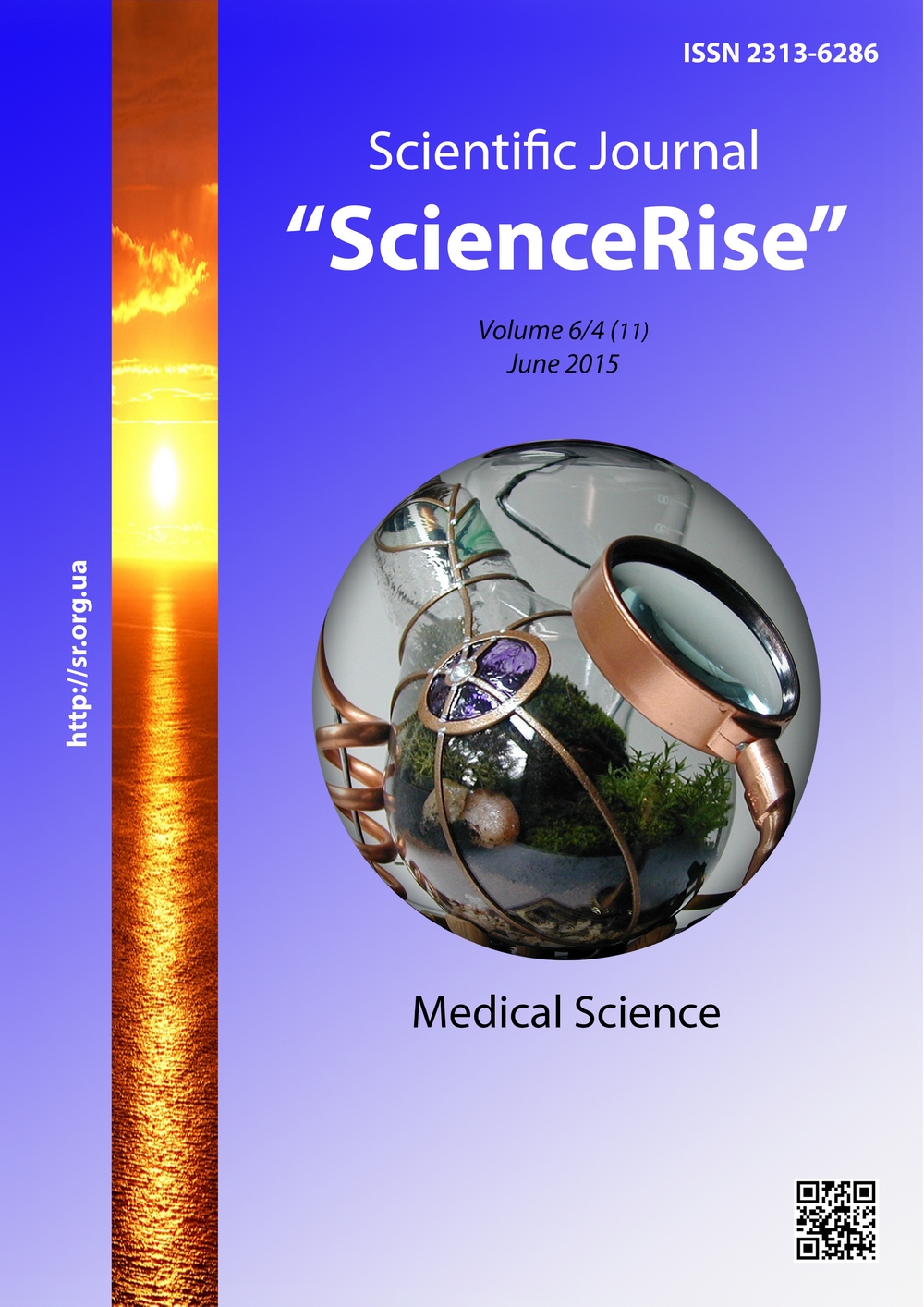Активність каспази-3 та катепсину д при різних підтипах ішемічного інсульту
DOI:
https://doi.org/10.15587/2313-8416.2015.45158Słowa kluczowe:
гострий період ішемічного інсульту, апоптоз, каспаза-3, катепсин ДAbstrakt
У 232 хворих гострому періоді різних підтипів ішемічного інсульту (ІІ) спостерігалася мітохондріальна дисфункція, апоптоз та некроз лейкоцитів крові, які були найбільш вираженим при атеротромботичному ішемічному інсульті (АТІ). При АТІ протягом першого тижня зростала активність катепсину Д, що свідчило і про лізосомальний шлях активації апоптозу при даному підтипі ІІ. Найвища активність каспази-3, яка не корелювала з кількістю клітин у стадії апоптозу, виявлена при лакунарному інсульті (ЛІ), (необхідно пояснення абревіатури) що пов'язано з переважним впливом каспази-3 на ендотелій та підвищення проникливості ГЕБ
Bibliografia
Kelly, P. J., Morrow, J. D., Ning, M., Koroshetz, W., Lo, E. H., Terry, E. et. al. (2007). Oxidative Stress and Matrix Metalloproteinase-9 in Acute Ischemic Stroke: The Biomarker Evaluation for Antioxidant Therapies in Stroke (BEAT-Stroke) Study. Stroke, 39 (1), 100–104. doi: 10.1161/strokeaha.107.488189
Broughton, B. R. S., Reutens, D. C., Sobey, C. G. (2009). Apoptotic Mechanisms After Cerebral Ischemia. Stroke, 40 (5), e331–e339. doi: 10.1161/strokeaha.108.531632
Sugawara, T., Noshita, N., Lewén, A. et. al. (2002). Overexpression of copper/zinc superoxide dismutase in transgenic rats protects vulnerable neurons against ischemic damage by blocking the mitochondrial pathway of caspase activation. J Neurosci, 22 (1), 209–217.
Rami, A., Sims, J., Botez, G., Winckler, J. (2003). Spatial resolution of phospholipid scramblase 1 (PLSCR1), caspase-3 activation and DNA-fragmentation in the human hippocampus after cerebral ischemia. Neurochemistry International, 43 (1), 79–87. doi: 10.1016/s0197-0186(02)00194-8
Boya, P., Kroemer, G. (2008). Lysosomal membrane permeabilization in cell death. Oncogene, 27 (50), 6434–6451. doi: 10.1038/onc.2008.310
Conus, S., Pop, C., Snipas, S. J., Salvesen, G. S., Simon, H.-U. (2012). Cathepsin D Primes Caspase-8 Activation by Multiple Intra-chain Proteolysis. Journal of Biological Chemistry, 287 (25), 21142–21151. doi: 10.1074/jbc.m111.306399
Carew, J. S., Espitia, C. M., Esquivel, J. A., Mahalingam, D., Kelly, K. R., Reddy, G. et. al. (2010). Lucanthone Is a Novel Inhibitor of Autophagy That Induces Cathepsin D-mediated Apoptosis. Journal of Biological Chemistry, 286 (8), 6602–6613. doi: 10.1074/jbc.m110.151324
Kaschina, E., Scholz, H., Steckelings, U. M., Sommerfeld, M., Kemnitz, U. R., Artuc, M. et. al. (2009). Transition from atherosclerosis to aortic aneurysm in humans coincides with an increased expression of RAS components. Atherosclerosis, 205 (2), 396–403. doi: 10.1016/j.atherosclerosis.2009.01.003
Dingle, J. T., Barrett, A. J., Weston, P. D. (1971). Cathepsin D Characteristics of immunoinhibition and the confirmation of a role in cartilage breakdown Biochem. J., 123, 1–13.
Karaflou, M., Lambrinoudaki, I., Christodoulakos, G. (2008). Apoptosis in Atherosclerosis: A Mini-Review. Mini-Reviews in Medicinal Chemistry, 8 (9), 912–918. doi: 10.2174/138955708785132765
Liang, J.-M., Xu, H.-Y., Zhang, X.-J., Li, X., Zhang, H.-B., Ge, P.-F. (2013). Role of mitochondrial function in the protective effects of ischaemic postconditioning on ischaemia/reperfusion cerebral damage. Journal of International Medical Research, 41 (3), 618–627. doi: 10.1177/0300060513476587
Zehendner, C. M., Librizzi, L., Hedrich, J., Bauer, N. M., Angamo, E. A., de Curtis, M., Luhmann, H. J. (2013). Moderate Hypoxia Followed by Reoxygenation Results in Blood-Brain Barrier Breakdown via Oxidative Stress-Dependent Tight-Junction Protein Disruption. PLoS ONE, 8 (12), e82823. doi: 10.1371/journal.pone.0082823
Lee, S.-R., Lo, E. H. (2004). Induction of Caspase-Mediated Cell Death by Matrix Metalloproteinases in Cerebral Endothelial Cells After Hypoxia–Reoxygenation. Journal of Cerebral Blood Flow & Metabolism, 24 (7), 720–727. doi: 10.1097/01.wcb.0000122747.72175.47
Lankiewicz, S., Marc Luetjens, C., Nguyen Truc Bui, Krohn, Aaron J., Poppe, Monika et. al. (2000). Activation of calpain I converts ex citotoxic neuron death into a caspase-independent cell death. Journal of Biological Chemistry, 275 (22), 17064–17071. doi: 10.1074/jbc.275.22.17064
Matulevicius, S., Rohatgi, A., Khera, A., Das, S. R., Owens, A., Ayers, C. R. et. al. (2008). The association between plasma caspase-3, atherosclerosis, and vascular function in the Dallas Heart Study. Apoptosis, 13 (10), 1281–1289. doi: 10.1007/s10495-008-0254-1
Heinrich, M., Neumeyer, J., Jakob, M., Hallas, C., Tchikov, V., Winoto-Morbach, S. et. al. (2004). Cathepsin D links TNF-induced acid sphingomyelinase to Bid-mediated caspase-9 and -3 activation. Cell Death Differ, 11 (5), 550–563. doi: 10.1038/sj.cdd.4401382
Madge, L. A., Li, J.-H., Choi, J., Pober, J. S. (2003). Inhibition of Phosphatidylinositol 3-Kinase Sensitizes Vascular Endothelial Cells to Cytokine-initiated Cathepsin-dependent Apoptosis. Journal of Biological Chemistry, 278 (23), 21295–21306. doi: 10.1074/jbc.m212837200
Broker, L. E. (2005). Cell Death Independent of Caspases: A Review. Clinical Cancer Research, 11 (9), 3155–3162. doi: 10.1158/1078-0432.ccr-04-2223
##submission.downloads##
Opublikowane
Numer
Dział
Licencja
Copyright (c) 2015 Наталія Романівна Сохор, Світлана Іванівна Шкробот, Олена Юріївна Бударна, Оксана Романівна Ясний

Utwór dostępny jest na licencji Creative Commons Uznanie autorstwa 4.0 Międzynarodowe.
Our journal abides by the Creative Commons CC BY copyright rights and permissions for open access journals.
Authors, who are published in this journal, agree to the following conditions:
1. The authors reserve the right to authorship of the work and pass the first publication right of this work to the journal under the terms of a Creative Commons CC BY, which allows others to freely distribute the published research with the obligatory reference to the authors of the original work and the first publication of the work in this journal.
2. The authors have the right to conclude separate supplement agreements that relate to non-exclusive work distribution in the form in which it has been published by the journal (for example, to upload the work to the online storage of the journal or publish it as part of a monograph), provided that the reference to the first publication of the work in this journal is included.

